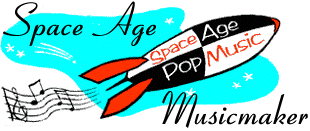Home · Listener's Guide · The Songs · Who's Who · Liner Notes · Selected Tracks · What's New · Search

Beaver and Krause
Paul Beaver
- Born Ohio 1926
- Died 16 January 1975, Los Angeles, California
- Born 8 December 1938, Detroit, Michigan
For better or worse, Paul Beaver and Bernie Krause probably had more to do with introducing the synthesizer into rock music than anyone else. Beaver was a veteran of the Hollywood studio system, known as a sound effects man but, in fact, something of an innovator in electronic music. Krause, a dozen years younger, had moved from Detroit to Cambridge to L.A. to San Francisco, working as a guitar player, folk singer, and session man, and was becoming interested in electronic music.
They met through Elektra Records president Jac Holzman, who was looking for someone to add electronic effects to a record Mort Garson was arranging: The Zodiac: Cosmic Signs. Remembering Beaver from a recording session, Krause contacted him and the pair agreed to collaborate. They also realized that there was a potential to land other recording deals if they had the equipment to produce weird sounds to order. Beaver contacted the synthesizer pioneer Robert Moog, enticing him with an offer to act as Moog's sales rep on the West Coast. Moog flew out, and after convincing the pair of the road-worthiness of his synthesizer by shoving it off a table and then playing it again, they decided to sink their life savings into buying a Series III, Moog's most expensive model.
The partners spent fruitless months trying to get someone in Hollywood interested in using it. They decided to set up a booth at the Monterey Pop Festival in 1967, and on the airplane ride back, Holzman decided to release an album demonstrating the possibilities of the Moog on his budget label, Nonesuch. Nonesuch was already one of the more interesting labels around, with a diverse catalog including Gregorian chants, baroque concerti, Egyptian oud music, and Javanese gamelan ensembles. Despite its ungainly title, The Nonesuch Guide to Electronic Music ended up as the label's top-selling album for several years after its release in late 1967. In their book, Analog Days, authors Trevor Pinch and Frank Trocco refer to it as "the only technical manual in the history of music to become a hit record."
Through their exposure there, a trickle of feelers from acts like the Doors, the Byrds, the Rolling Stones, Simon and Garfunkel, and others built into a steady stream of business. Soon they were some of the busiest session men in L.A. (playing on Martin Denny's Exotic Moog album and the soundtrack for "Rosemary's Baby," among many other gigs), and he and Krause earned a contract with Warner Brothers.
The three albums allowed Beaver and Krause to explore their individual interests in a collaborative project. Beaver moved beyond simply using the Moog as a colorful instrument in relatively conventional pieces. Krause took a microphone and a portable tape recorder and wandered around San Francisco, recording environmental sounds--monkeys at the zoo, sea lions around Fort Point, seagulls, clacks of the cable car tow chains, and rumbles of city busses. They also recorded with studio musicians, including Bud Shank and Howard Roberts, and a truckload of exotic instruments). They then assembled eight original sound pieces out of the myriad fragments, creating what (also for better or for worse) can now be seen as a pioneering work of new age music.
Ironically, their most popular album for Warner Brothers, Gandharva, was recorded from a live performance at Grace Cathedral in San Francisco (which had become something of a part-time studio, thanks to Cal Tjader, Vince Guaraldi, Duke Ellington, and others).
The pair were working on an update to the Nonesuch Guide when Beaver suddenly of a brain aneurism in 1975. Krause grew disillusioned with the superficial use to which electronic music and effects were being used, and he eventually found that field recording was closer to his real passion, allowing him to combine his electronics expertise with his interest in the environment. He went back to college and earned a doctorate in a field he was already defining, bioacoustics.
Since then, Krause has traveled the world from pole to pole, recording the sounds of nature in the wild. He has recorded everything from insect larva to bathing hippopotamuses, from crashing ice floes to a cottonwood tree sucking up water after a rain storm. His library includes over 3500 hours of field records and documents the sounds of over 15,000 creatures. Through his company, Wild Sanctuary, Krause has sold over 1.5 million CDs and tapes of natural "sound sculptures" created from these tapes. He's also written an autobiography, Into a Wild Sanctuary: A Life in Music and Natural Sound, and a guide to field recording, Wild Soundscapes: Discovering the Voice of the Natural World.
Krause jokes that his work in the field comes with "No telephones. No news. No Monica Lewinsky," but he clearly sees it as a race against time. "In 30 years, 20 percent of the habitats I've recorded have become extinct."
Recordings
- The Nonesuch Guide to Electronic Music, Nonesuch LP HC 73018
- All Good Men, Warner Brothers WBS 1950
- Gandharva, Warner Brothers WBS 1909
- In a Wild Sanctuary, Warner Brothers WBS 2624
S p a c e A g e P o p M u s i c
Home · Listener's Guide · The Songs · Who's Who · Liner Notes · Selected Tracks · What's New · Search
Email: editor@spaceagepop.com